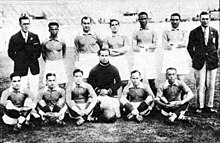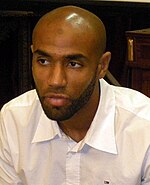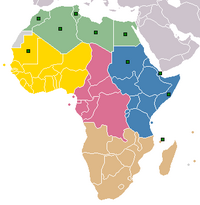Portal:Football in Africa
Introduction
Football is the most popular sport in Africa. Indeed, football is probably the most popular sport in every African country, although rugby and cricket are also very popular in South Africa. (Full article...)
This section may be unbalanced toward certain viewpoints. (October 2022) |

Selected article -
Al Ahly Sporting Club (Arabic: النادي الأهلي الرياضي), commonly known as Al Ahly, is an Egyptian professional sports club based in Cairo, Egypt. The club is mainly known for its professional football team which currently plays in the Egyptian Premier League, the highest tier in the Egyptian football league system. The club is renowned for its consistent success at both domestic and continental levels, regularly contending in CAF tournaments.
Founded on 24 April 1907 by Omar Lotfy , Al Ahly has a record of 43 Egyptian Premier League titles, 39 Egypt Cup titles and 14 Egyptian Super Cups. Al Ahly is the most successful club in Africa.
In international competitions, the club has won a record 12 CAF Champions League titles, 1 CAF Confederation Cup, a record of 8 CAF Super Cups, a record of 4 African Cup Winners' Cups, 1 Afro-Asian Club Championship, 1 Arab Club Champions Cup, 1 Arab Cup Winners' Cup, a record of 2 Arab Super Cups, and has won 4 bronze medals in the FIFA Club World Cup. With 25 official continental titles, Al Ahly was voted by CAF as the African club of the 20th century.
Selected biography -
Kanouté began his career with Lyon in France before moving to West Ham of the Premier League in 2000. After a spell at their London rivals Tottenham Hotspur, Kanouté moved to Spanish club Sevilla where he won two consecutive UEFA Cups in 2006 and 2007 in addition to various other European and domestic honours and remains the club's highest-scoring foreign player. He joined Beijing Goan in June 2012.
Despite appearing 16 times for France U-21, Kanouté was a member of the Malian squad which reached the semi-finals of the 2004 African Cup of Nations and also featured in their selections for the tournament in 2006 and 2010. His international career ended in 2010 with a total of 39 caps and 23 goals.
Selected image -
| [[Image:|center|400px|A view of the FNB Stadium after a 2010 FIFA World Cup match]] |
A view of the FNB Stadium after the 2010 FIFA World Cup Group D match between Ghana and Germany on 23 June 2010. Nicknamed Soccer City and the Calabash, the stadium is the largest in Africa with a capacity of 94,736. It is the home ground of South African giants Kaizer Chiefs and the South Africa national team.
Subcategories
Related portals
More sports portals
WikiProjects
Related task forces and sub-projects
African football task force
WikiProject Africa • WikiProject Football
WikiProject Football task forces and sub-projects
 | |
| Wikipedia ads | file info – #250 |
Topics
Open tasks

- Expand stubs: Competitions in Africa • Organizations
- Expand club articles of teams from Africa.
- Expand biographies of Africans involved in football.
- Create: Requested articles • Most wanted football articles • Requested general football articles
- Add: Infoboxes • Images (General requests, Requested images of people)
- Review: articles currently under review
- Assess: Assessment requests • Assess an article
- Revert vandalism on this portal and on African football articles
- Assist in maintaining this portal and keeping its selected content up to date.
- WikiNews: Create and submit news stories about African football for Wikipedia's sister project WikiNews.
Associated Wikimedia
The following Wikimedia Foundation sister projects provide more on this subject:
-
Commons
Free media repository -
Wikibooks
Free textbooks and manuals -
Wikidata
Free knowledge base -
Wikinews
Free-content news -
Wikiquote
Collection of quotations -
Wikisource
Free-content library -
Wikiversity
Free learning tools -
Wiktionary
Dictionary and thesaurus
More portals
Sources

- ^ "The History Of Soccer In Africa". NPR.org. 2010-06-09. Retrieved 2016-03-31.
- ^ a b c Alegi, Peter (2010). African Soccerscapes. Ohio University Press. pp. 1–2. ISBN 9780896802780.
- ^ Frimpong, Enoch Darfah. "Ghana news: A world of superstition, frustration and disillusionment - Graphic Online". Retrieved 23 September 2017.
- ^ Lacey, Marc (8 August 2002). "Kangemi Journal; For Spellbinding Soccer, the Juju Man's on the Ball". The New York Times. NY Times. Retrieved 2016-03-31.
- ^ "World Cup Witchcraft: Africa Teams Turn to Magic for Aid". National Geographic. Archived from the original on July 10, 2006. Retrieved 2016-03-31.
- ^ Andy Mitten (September 2010). The Rough Guide to Cult Football. Rough Guides UK. ISBN 9781405387965. Retrieved 2016-04-02.
- ^ "African Nations Cup overshadowed by hocus pocus | Football". The Guardian. Retrieved 2016-04-09.
- ^ Kuper, Simon (2006). Soccer Against the Enemy: How the World's Most Popular Sport Starts and Stops Wars, Fuels Revolutions, and Keeps Dictators in Power. Nation Books. p. 123. ISBN 978-1-56025-878-0.

























